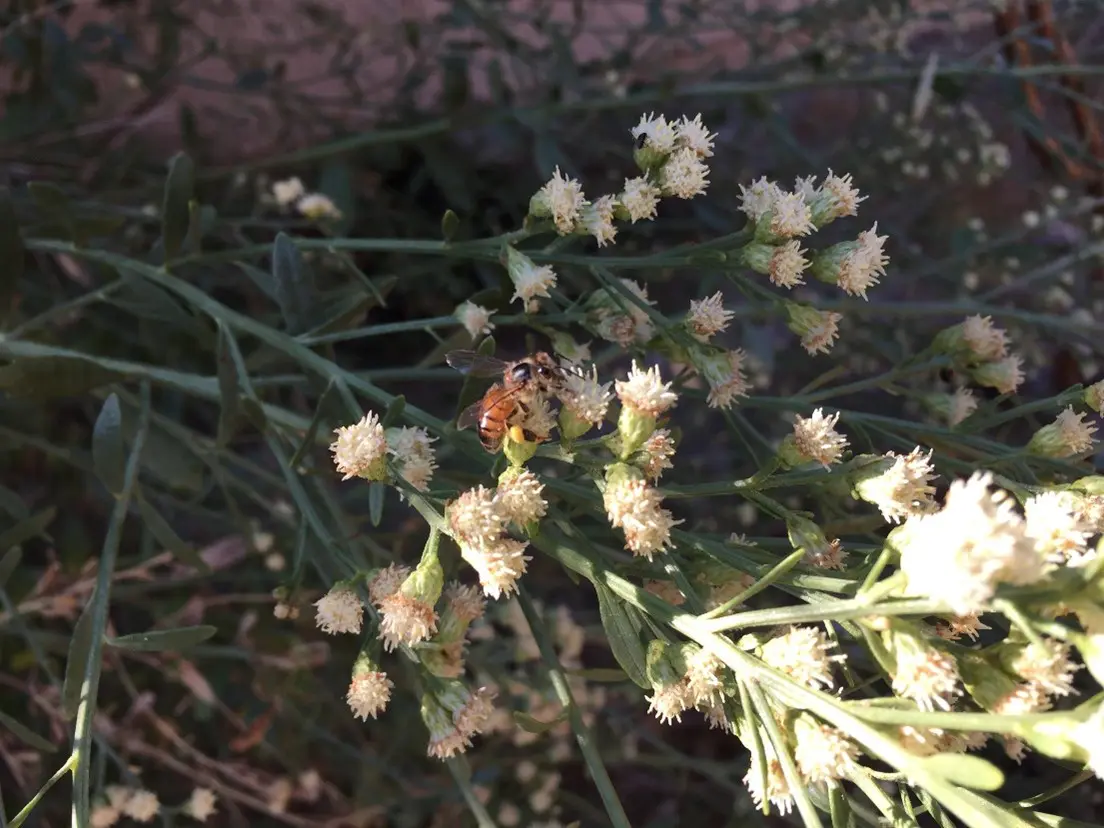The Seep Willow

Can This Plant Be A Sunflower? Really?
It is, though just looking at its fuzzy, white flowers, you might not think so. Seep willow, ( Baccharis salicina; also called coyote bush, willow baccharis, Great Plains false willow, and Emory’s baccharis), and two of its close relatives, mule fat (Baccharis salicifolia) and desert broom (Baccharis sarothroides) really are members of the large and diverse sunflower family. Interestingly, all three are found in Clark County Wetlands Park.
While we humans would certainly not eat its hairy, sticky white flowers, a seep willow in bloom gathers “grocery-shopping” pollinators in great numbers, like the honeybee in this photo. The shrub’s small flowers are arranged in flat-topped clusters, making them great landing platforms for insect pollinators. Some bushes in full flower closely resemble a traffic light at rush hour. The crowds in search of nectar and pollen may include a wide variety of bees (including European Honey Bee, Apis mellifera) , butterflies, wasps, and hover flies.
In the United States, seep willow is native to the southern Great Plains and the arid southwest. But its range extends into northern Mexico and even as far south as Guatemala and Honduras. Since it grows well in the tropics, you might guess that desert heat is no problem for seep willow. While the plant can tolerate heat, it requires regular access to water.
Throughout the arid southwest, seep willow can form dense thickets five to twelve feet tall in the riparian “ribbon of green” habitat along streams and pond margins. It seems to prefer mildly alkaline conditions, and will (more rarely) grow along washes with intermittent water flow, as long as its roots can reach the groundwater below the surface. The shrubs are quick-growing and will rapidly line the banks of irrigation canals in agricultural areas. The nearly evergreen leaves are coated with a sticky resin that reduces water loss and increases the plant’s drought tolerance.
Seep willow thickets provide shade and cover for small mammals and are used for nesting by red-wing blackbirds. Native American societies, including the Aztecs, used seep willow leaves and stems to make a wash for an itchy hair and scalp, reduce swelling, and treat wounds. Much more recently, phytochemists have discovered a possible reason for this: the plant’s foliage contains several compounds that inhibit bacterial activity!
While the blooming season for seep willow can range literally from spring to fall, late September into October are wonderful times to observe the “rush” of pollinators in the Park. Keep an eye peeled for dense stands of seep willow bursting with white flower clusters as you walk the fall trails. If you have a keen ear, all the “fluttering and buzzing” may lead you to the plants, or you may actually smell them as you approach. I love the pungent, slightly astringent scent, but some people tell me they find the blooms a real “sneeze-magnet!”
– By Chris Leavitt, President; photo by Chris Leavitt
